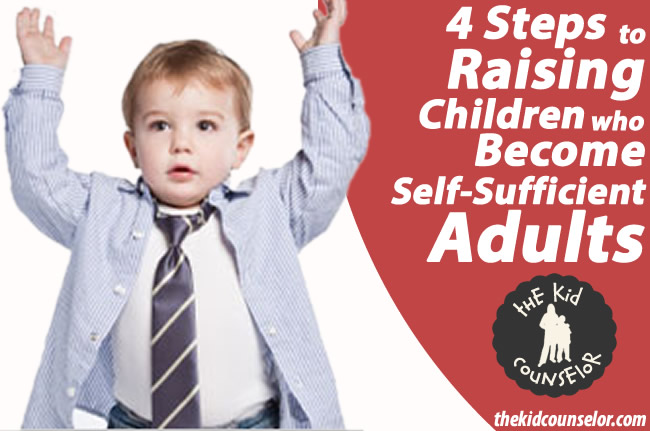I was in a course last year with a woman who was widowed when her two children were young. She made a comment at one point that she realized early after her husband’s death that her “job as a mother was to prepare her children to succeed without her.” This has stayed with me ever since, especially when I think about what I need to be considering each day to prepare my son for adulthood. And, of course, then I look to play therapy principles for how to effectively implement that preparation. Here are four steps to raising self-sufficient kids:
1. Let your child do things for themselves.
Children need to experience the benefits of doing things for themselves. Children are almost always more capable than parents assume or allow. Among the positive outcomes are increased self-esteem, feelings of accomplishment, the development of competence, problem solving skills and understanding of oneself. You can prompt a child to do things for him or herself in simple ways, by encouraging them: “You can do it by yourself” and by letting them struggle to achieve success: “You have what it takes to figure it out.” Children who grow up with a strong sense of personal accomplishment become adults who are willing to take chances and believe in their abilities.
2. Encourage them.
On the surface, this may seem like a given, but in this case I mean encouragement rather than praise. Encouraging your child focuses on their effort rather than the outcome and creates internal motivation to succeed. Praise hinges on your evaluation of the situation, and makes children perform in order to get your approval. Encouraging them would sound like: “You did it!” or “You worked hard on that!” (Read more about Praise vs. Encouragement here.) Children who understand their strengths and find value in their abilities become adults who work hard with personal determination to succeed.
3. Set limits on their behavior.
Children need and want limits, and need consistent awareness of expectations. When you provide limits, you offer your children the opportunity to learn about self-regulation, self-control, and understanding of consequences. Set limits on behaviors that are inappropriate, in three simple steps: “I know you want to color, but the walls are not for coloring on. You can choose to color on paper.” (Read more about Limit Setting here.) Children who grow up with limits are able to control their own behaviors and accept the results of their actions as adults, rather than blaming others for their actions.
4. Give them choices.
Children are very infrequently given the chance to be in control of their lives. They are given very little power over their circumstances, and infrequently are able to exercise their decision making skills. Choices can be given to empower kids to understand what they want and accept the results of their actions. Give young kids simple choices and older kids choices with more weight: “You can choose to wear sandals or tennis shoes” versus “You can choose to mow the yard or wash the car.” (Read more about Choice Giving here. Children who grow up understanding that making a decision is empowering and choices automatically come with responsibility become adults who are able to effectively weigh outcomes and wisely decide on a plan of action.
In recent years, there has been an increase in entitled children who struggle to survive in the real world (Read more about Generation Y here) and parents who hover over their children’s every move like helicopters (thus the term “helicopter parents”.) It is easy to make decisions for your kids and try to guide them as much as possible when they are young. What is important to remember, however, is you do your children a much greater service by equipping them to thrive when you are no longer in charge by encouraging appropriate independence and self-sufficiency.

